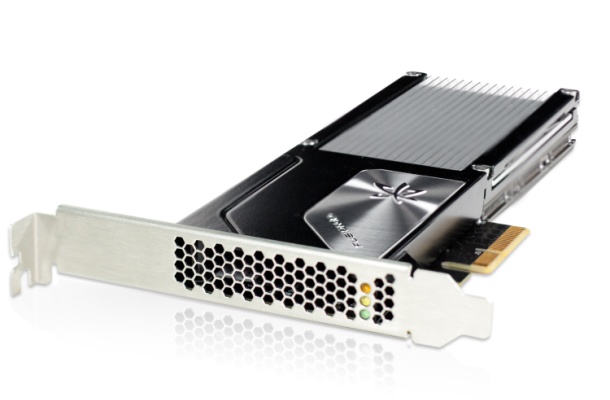Fusion-io taps flash for virtual cache

Fusion-io has integrated flash caching into VMware virtualised environments via a software and hardware bundle.

VMware has unveiled ioCache, which bundles ioMemory hardware and ioTurbine software. Photo credit: Fusion-io
On Monday, the company unveiled ioCache, which bundles ioMemory hardware and ioTurbine software, at the VMworld conference in Las Vegas. It is designed to let data-intensive virtual applications, such as databases or SharePoint, use server-attached flash storage as a substitute for RAM. Previously, Fusion-io's technology worked only in non-virtualised environments.
"All servers [can be] managed as if they were one system," Fusion-io's chief executive David Flynn told ZDNet UK. "Fusion-io levels the playing field so common hardware can run demanding problems. You don't need Netezza," he said.
ioCache uses ioTurbine technology, which Fusion-io gained in its acquisition of IO Turbine in early August. The technology provides a method for virtualised environments to federate virtual machines' storage across Fusion-io flash hardware. Fusion-io has been working with IO Turbine on the technology for around a year, Flynn said.
Fusion-io's products, such as the ioDrive, link flash memory to servers — and by extension their CPUs — via PCIe. This allows storage pools to be brought closer to the CPU than if linked in via the storage network, which has been Oracle and NetApp's approach. ioCache's ioMemory flash card works in a similar manner and is capable of up to 600Gbps of capacity, Fusion-io said.
Any virtualised application that requires a high amount of data transfer, such as Microsoft SharePoint or Exchange, can benefit from ioCache, Flynn said. If adopted, the technology should allow companies to get rid of underused parts of their storage area network (SAN) as well, he added. This is because the flash module eases input/output (I/O) demands on the SAN substrate by optimising traffic at the point where the virtual machine calls to the server, rather than optimising traffic to the server and through to the SAN and back.
"Just as RAM benefits from close integration within the server, our VSL [virtual storage layer] subsystem integrates ioMemory within the server as a true memory resource to eliminate the complexity and latency introduced when accessing flash through storage protocols and embedded CPUs," Flynn said in a statement.
If needed, the ioTurbine software can be paired with the larger ioDrive cards, rather than the flash modules, Fusion-io said.
No competition
Flynn believes Fusion-io faces scant competition in the marketplace, even though EMC has announced its own PCIe-based flash technology, known as Project Lightning.
"Even though EMC talk about Project Lightning they still say it's a corner case," he said. "What they're trying to do is confuse the market."
Flynn also believes that linking flash to storage systems, as NetApp does with its Flash Cache technology, is a step in the wrong direction. He argues it centralises the storage, which creates more I/O bottlenecks than a distributed system such as that provided by Fusion-io.
"[Flash Cache] is endoskeletal versus exoskeletal," he said.
The ioCache hardware and associated ioTurbine software is scheduled for release in the fourth quarter. Customers can expect to pay around $6,900 (£4,205) per physical server, or $3,900 per server if they are just licensing the software.
Get the latest technology news and analysis, blogs and reviews delivered directly to your inbox with ZDNet UK's newsletters.